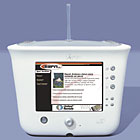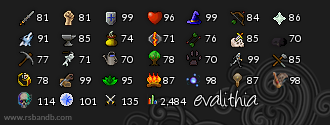At PC World, we spend most of our time talking about products that make your life easier or your work more productive. But it's the lousy ones that linger in our memory long after their shrinkwrap has shriveled, and that make tech editors cry out, "What have I done to deserve this?"
25. Sharp RD3D Notebook (2004)

As the first "autostereo" 3D notebook, Sharp's RD3D was supposed to display 3D images without requiring the use of funny glasses. But "auto-headache" was more like it, as the RD3D was painful to look at.
When you pressed the button to enable 3D mode, the notebook's performance slowed, and the 3D effect was noticeable only within a very narrow angle--and if you moved your head, it disappeared. Maybe the funny glasses weren't so bad after all.
24.DigiScents iSmell (2001)

Few products literally stink, but this one did--or at least it would have, had it progressed beyond the prototype stage.
In 2001, DigiScents unveiled the iSmell, a shark-fin-shaped gizmo that plugged into your PC's USB port and wafted appropriate scents as you surfed smell-enabled Web sites--say, perfume as you were browsing Chanel.com, or cheese doodles at Frito-Lay.com. But skeptical users turned up their noses at the idea, making the iSmell the ultimate in vaporware.
23. Free PCs (1999)
In the late 90s, companies competed to dangle free PCs in front of you: All you had to do was sign up, and a PC would eventually show up at your door. But one way or another. there was always a catch: You had to sign up for a long-term ISP agreement, or tolerate an endless procession of Web ads, or surrender reams of personal information. Free-PC.com may have been the creepiest of them all. First you filled out an extensive questionnaire on your income, interests, racial and marital status, and more. Then you had to spend at least 10 hours a week on the PC and at least 1 hour surfing the Web using Free-PC's ISP.
In return you got a low-end Compaq Presario with roughly a third of the screen covered in ads. And while you watched the PC (and the ads), Free-PC watched you--recording where you surfed, what software you used, and who knows what else.
We can't say whether this would have led to some Big Brotherish nightmare, because within a year Free-PC.com merged with eMachines. By then, other vendors had similarly concluded that "free" computers just didn't pay.
22. Apple Pippin @World (1996)

Before Xbox, before PlayStation, before DreamCast, there was Apple's Pippin. Wha-huh? That's right--Apple had an Internet-capable game console that connected to your TV. But it ran on a weak PowerPC processor and came with a puny 14.4-kbps modem, so it was stupendously slow offline and online.
Then, too, it was based on the Mac OS, so almost no games were available for it. And it cost nearly $600--nearly twice as much as other, far more powerful game consoles. Underpowered, overpriced, and underutilized--that pretty much describes everything that came out of Apple in the mid-90s.
21.Eyetop Wearable DVD Player (2004)

(i remember this from Tech now)
Some things just aren't meant to be done while walking or driving, and one of them is watching DVDs. Unfortunately, that message was lost on Eyetop.net, makers of the Eyetop Wearable DVD Player.
This system consisted of a standard portable DVD player attached to a pair of heavy-duty shades that had a tiny 320-by-240-pixel LCD embedded in the right eyepiece. You were supposed to carry the DVD player and battery pack in an over-the shoulder sling, put on the eyeglasses, and then... squint. Or maybe wear a patch on your left eye as you walked and watched at the same time.
Up close, the LCD was supposed to simulate a 14-inch screen. Unfortunately, the only thing the Eyetop stimulated was motion sickness.
20. DigitalConvergence CueCat (2000)

Appearing at the tail end of the dot com craze, the CueCat was supposed to make it easier for magazine and newspaper readers to find advertisers' Web sites (because apparently it was too challenging to type
http://www.pepsi.com into your browser).
The company behind the device, DigitalConvergence, mailed hundreds of thousands of these cat-shaped bar-code scanners to subscribers of magazines and newspapers. Readers were supposed to connect the device to a computer, install some software, scan the barcodes inside the ads, and be whiskered away to advertisers' websites. Another "benefit": The company used the device to gather personally identifiable information about its users.
The CueCat's maker was permanently declawed in 2001, but not before it may have accidentally exposed its user database to hackers.
19. OQO Model 1 (2004)
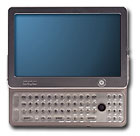
The 14-ounce OQO Model 1 billed itself as the "world's smallest Windows XP computer"--and that was a big part of its problem. You needed a magnifying glass to read icons or text on its 5-by-3-inch screen, and the hide-away keypad was too tiny to accommodate even two adult fingers.
The Model 1 also ran hot to the touch, and at $1900+ it could easily burn a hole in your wallet. Good things often come in small packages, but not this time.
18. IBM Deskstar 75GXP (2000)
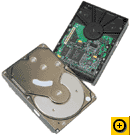
Fast, big, and highly unreliable, this 75GB hard drive was quickly dubbed the "Deathstar" for its habit of suddenly failing and taking all of your data with it.
About a year after IBM released the Deskstar, users filed a class action suit, alleging that IBM had misled customers about its reliability. IBM denied all liability, but last June it agreed to pay $100 to Deskstar owners whose drives and data had departed their desks and gone on to a celestial reward. Well before that, IBM had washed its hands of the Deathstar, selling its hard drive division to Hitachi in 2002.
17. Apple Macintosh Portable (1989)
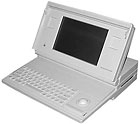
(1989!!!)
Some buildings are portable, if you have access to a Freightliner. Stonehenge is a portable sun dial, if you have enough people on hand to get things rolling. And in 1989, Apple offered a "portable" Macintosh--a 4-inch-thick, 16-pound beast that severely strained the definition of "laptop"--and the aching backs of its porters.
Huge lead-acid batteries contributed to its weight and bulk; the batteries were especially important because Portable wouldn't run on AC power. Some computers are affordable, too; the Portable met that description only if you had $6500 of extra cash on hand.
16. Comet Systems Comet Cursor (1997)

Thank the Comet Cursor for introducing spyware to an ungrateful nation. This simple program had one purpose: to change your mouse cursor into Bart Simpson, Dilbert, or one of thousands of other cutesy icons while you were visiting certain Web sites. But Comet had other habits that were not so cute.
For example, it assigned your computer a unique ID and phoned home whenever you visited a Comet-friendly Web site. It secretly installed itself into Internet Explorer when you visited certain sites or installed other free software like RealPlayer 7 (yet another reason to loathe RealPlayer). Some versions would hijack IE's search assistant or cause the browser to crash.
Though Comet's founders insisted that the program was not spyware, thousands of users disagreed. Comet Systems was bought by pay-per-click ad company FindWhat in 2004; earlier this year, Comet's cursor software scurried down a mouse hole, never to be seen again.
15. Iomega Zip Drive (1998)
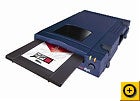
Click-click-click. That was the sound of data dying on thousands of Iomega Zip drives. Though Iomega sold tens of millions of Zip and Jaz drives that worked flawlessly, thousands of the drives died mysteriously, issuing a clicking noise as the drive head became misaligned and clipped the edge of the removable media, rendering any data on that disc permanently inaccessible.
Iomega largely ignored the problem until angry customers filed a class action suit in 1998, which the company settled three years later by offering rebates on future products. And the Zip disk, once the floppy's heir apparent, has largely been eclipsed by thumb drives and cheaper, faster, more capacious rewritable CDs and DVDs.
14. Gateway 2000 10th Anniversary PC (1995)
After a decade as one of the computer industry's major PC builders, the folks at Gateway 2000 wanted to celebrate--not just by popping a few corks, but by offering a specially configured system to show some customer appreciation.
But instead of Cristal champagne, buyers got Boone's Farm--the so-called 6X CD-ROM spun at 4X or slower (a big performance hit in 1995), the video card was a crippled version of what people thought they were getting, and the surround-sound speakers weren't actually surround-capable. Perhaps Gateway was sticking to the traditional gift for a tenth anniversary: It's tin, not gold.
13. IBM PCjr. (1984)
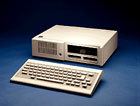
(this thing is older than me man)
IBM's attempt to build an inexpensive computer for homes and schools was an orphan almost from the start. The infamous "Chiclet" keyboard on the PCjr. was virtually unusable for typing, and the computer couldn't run much of the software written for its hugely successful parent, the IBM PC.
A price tag nearly twice that of competing home systems from Commodore and Atari didn't improve the situation. Two years after Junior's splashy debut, IBM sent him to his room and never let him out again.
12. PointCast Network (1996)

Back in the mid-90s, so-called "push" technology was all the rage. In place of surfing the Web for news and information, push apps like the PointCast Network would deliver customized information directly to your desktop--along with a healthy serving of ads. But push quickly turned into a drag, as PointCast's endless appetite for bandwidth overwhelmed dial-up connections and clogged corporate networks.
In addition, PointCast's proprietary screensaver/browser had a nasty habit of commandeering your computer and not giving it back. Companies began to ban the application from offices and cubicles, and push got shoved out the door. Ironically, the idea of push has made a comeback of sorts via low-bandwidth RSS feeds. But too late for PointCast, which sent out its last broadcast in early 2000.
11. Priceline Groceries and Gas (2000)
The name-your-price model worked for airline tickets, rental cars, and hotels--why not groceries and gas? Unfortunately, even Priceline spokescaptain William Shatner couldn't keep these services in orbit. Grocery shoppers could find real discounts bidding for products online, but only if they weren't picky about brands and were willing to follow Byzantine rules on what they could buy and how they paid for them.
Fuel customers had to pay for petrol online, wait for a Priceline gas card to arrive in the mail, and then find a local station that would honor it--a lot of hassle to save a few pennies per gallon. In less than a year, WebHouse Club, the Priceline affiliate that ran both programs, ran out of gas--and cash--and was forced to shut down.
10. Ashton-Tate dBASE IV (1988)
In the early days of the PC, dBASE was synonymous with database. By the late 1980s, Ashton-Tate's flagship product owned nearly 70 percent of the PC database market. But dBASE IV changed all that. Impossibly slow and filled with more bugs than a rain forest, the $795 program was an unmitigated disaster.
Within a year of its release, Ashton-Tate's market share had plummeted to the low 40s. A patched-up version, dBASE IV 1.1, appeared two years later, but by then it was too late. In July 1991 the company merged with Borland, which eventually discontinued dBASE in favor of its own database products and sold the rights in 1999 to a new company, dataBased Intelligence, Inc.
9. Pressplay and MusicNet 2002

Digital music is such a great idea that even record companies finally, begrudgingly accepted it after years of implacable opposition. In 2002, two online services backed by music industry giants proposed giving consumers a legitimate alternative to illegal file sharing. But the services' stunningly brain-dead features showed that the record companies still didn't get it.
PressPlay charged $15 per month for the right to listen to 500 low-quality audio streams, download 50 audio tracks, and burn 10 tracks to CD. It didn't sound like an awful deal, until you found out that not every song could be downloaded, and that you couldn't burn more than two tracks from the same artist. MusicNet cost $10 per month for 100 streamed songs and 100 downloads, but each downloaded audio file expired after only 30 days, and every time you renewed the song it counted against your allotment.Neither service's paltry music selections could compete against the virtual feast available through illicit means. Several billion illegal downloads later, an outside company--Apple, with its iTunes Music Service--showed the record companies the right way to market digital music.
8. Microsoft Internet Explorer 6 (2001) (muHAHAHAHA rofl)
Full of features, easy to use, and a virtual engraved invitation to hackers and other digital delinquents, Internet Explorer 6.x might be the least secure software on the planet. How insecure? In June 2004, the U.S. Computer Emergency Readiness Team (CERT) took the unusual step of urging PC users to use a browser--any browser--other than IE. Their reason: IE users who visited the wrong Web site could end up infected with the Scob or Download.Ject keylogger, which could be used to steal their passwords and other personal information. Microsoft patched that hole, and the next one, and the one after that, and so on, ad infinitum.
To be fair, its ubiquity paints a big red target on it--less popular apps don't draw nearly as much fire from hackers and the like. But here's hoping that Internet Explorer 7 springs fewer leaks than its predecessor.
7. Microsoft Bob (1995)

(MS and walmart... bad combo)
No list of the worst of the worst would be complete without Windows' idiot cousin, Bob. Designed as a "social" interface for Windows 3.1, Bob featured a living room filled with clickable objects, and a series of cartoon "helpers" like Chaos the Cat and Scuzz the Rat that walked you through a small suite of applications. Fortunately, Bob was soon buried in the avalanche of hype surrounding Windows 95, though some of the cartoons lived on to annoy users of Microsoft Office and Windows XP (Clippy the animated paper clip, anyone?).
Mostly, Bob raised more questions than it answered. Like, had anyone at Microsoft actually used Bob? Did they think anyone else would? And did they deliberately make Bob's smiley face logo look like Bill Gates, or was that just an accident?
6. Disney The Lion King CD-ROM (1994)
Few products get accused of killing Christmas for thousands of kids, but that fate befell Disney's first CD-ROM for Windows. The problem: The game relied on Microsoft's new WinG graphics engine, and video card drivers had to be hand-tuned to work with it, says Alex St. John. He's currently CEO of game publisher WildTangent, but in the early 1990s he was Microsoft's first "game evangelist."
In late 1994, Compaq released a Presario whose video drivers hadn't been tested with WinG. When parents loaded the Lion King disc into their new Presarios on Christmas morning, many children got their first glimpse of the Blue Screen of Death. But this sad story has a happy ending. The WinG debacle led Microsoft to develop a more stable and powerful graphics engine called DirectX. And the team behind DirectX went on to build the Xbox--restoring holiday joy for a new generation of kids.
5. Sony BMG Music CDs (2005)
When you stick a music CD into your computer, you shouldn't have to worry that it will turn your PC into a hacker's plaything. But that's exactly what Sony BMG Music Entertainment's music discs did in 2005. The discs' harebrained copy protection software installed a rootkit that made it invisible even to antispyware or antivirus software. Any moderately clever cyber attacker could then use the same rootkit to hide, say, a keylogger to capture your bank account information, or a remote-access Trojan to turn your PC into a zombie.
Security researcher Dan Kaminsky estimated that more than half a million machines were infected by the rootkit. After first downplaying the problem and then issuing a "fix" that made things worse, Sony BMG offered to refund users' money and replace the faulty discs. Since then, the record company has been sued up the wazoo; a federal court judge recently approved a settlement in the national class action suit. Making your machine totally vulnerable to attacks--isn't that Microsoft's job?
4. Microsoft Windows Millennium (2000)
This might be the worst version of Windows ever released--or, at least, since the dark days of Windows 2.0. Windows Millennium Edition (aka Me, or the Mistake Edition) was Microsoft's follow-up to Windows 98 SE for home users. Shortly after Me appeared in late 2000, users reported problems installing it, getting it to run, getting it to work with other hardware or software, and getting it to stop running. Aside from that, Me worked great.
To its credit, Me introduced features later made popular by Windows XP, such as system restore. Unfortunately, it could also restore files you never wanted to see again, like viruses that you'd just deleted. Forget Y2K; this was the real millennium bug.
3. Syncronys SoftRAM (1995)
Back in 1995, when RAM cost $30 to $50 a megabyte and Windows 95 apps were demanding more and more of it, the idea of "doubling" your system memory by installing a $30 piece of software sounded mighty tempting. The 700,000 users who bought Syncronys's SoftRAM products certainly thought so. Unfortunately, that's not what they got.
It turns out that all SoftRAM really did was expand the size of Windows' hard disk cache--something a moderately savvy user could do without any extra software in about a minute. And even then, the performance boost was negligible. The FTC dubbed Syncronys's claims "false and misleading," and the company was eventually forced to pull the product from the market and issue refunds. After releasing a handful of other bad Windows utilities, the company filed for Chapter 7 bankruptcy in 1999. It will not be missed.
2. RealNetworks RealPlayer (1999)
n order for your browser to display the following paragraph this site must download new software; please wait. Sorry, the requested codec was not found. Please upgrade your system.
A frustrating inability to play media files--due in part to constantly changing file formats--was only part of Real's problem. RealPlayer also had a disturbing way of making itself a little too much at home on your PC--installing itself as the default media player, taking liberties with your Windows Registry, popping up annoying "messages" that were really just advertisements, and so on.
And some of RealNetworks' habits were even more troubling. For example, shortly after RealJukeBox appeared in 1999, security researcher Richard M. Smith discovered that the software was assigning a unique ID to each user and phoning home with the titles of media files played on it--while failing to disclose any of this in its privacy policy. Turns out that RealPlayer G2, which had been out since the previous year, also broadcast unique IDs. After a tsunami of bad publicity and a handful of lawsuits, Real issued a patch to prevent the software from tracking users' listening habits. But less than a year later, Real was in hot water again for tracking the habits of its RealDownload download-management software customers.
To be fair, RealNetworks deserves credit for offering a free media player and for hanging in there against Microsoft's relentless onslaught. We appreciate the fact that there's an alternative to Windows Media Player; we just wish it were a better one. ( we call that itunes)
and the NUMBER 1 worst product is!!!
1. America Online (1989-2006)
How do we loathe AOL? Let us count the ways. Since America Online emerged from the belly of a BBS called Quantum "PC-Link" in 1989, users have suffered through awful software, inaccessible dial-up numbers, rapacious marketing, in-your-face advertising, questionable billing practices, inexcusably poor customer service, and enough spam to last a lifetime. And all the while, AOL remained more expensive than its major competitors. This lethal combination earned the world's biggest ISP the top spot on our list of bottom feeders.
AOL succeeded initially by targeting newbies, using brute-force marketing techniques. In the 90s you couldn't open a magazine (PC World included) or your mailbox without an AOL disk falling out of it. This carpet-bombing technique yielded big numbers: At its peak, AOL claimed 34 million subscribers worldwide, though it never revealed how many were just using up their free hours.
Once AOL had you in its clutches, escaping was notoriously difficult. Several states sued the service, claiming that it continued to bill customers after they had requested cancellation of their subscriptions. In August 2005, AOL paid a $1.25 million fine to the state of New York and agreed to change its cancellation policies--but the agreement covered only people in New York.
Ultimately the Net itself--which AOL subscribers were finally able to access in 1995-- made the service's shortcomings painfully obvious. Prior to that, though AOL offered plenty of its own online content, it walled off the greater Internet. Once people realized what content was available elsewhere on the Net, they started wondering why they were paying AOL. And as America moved to broadband, many left their sluggish AOL accounts behind. AOL is now busy rebranding itself as a content provider, not an access service.
Though America Online has shown some improvement lately--with better browsers and e-mail tools, fewer obnoxious ads, scads of broadband content, and innovative features such as parental controls--it has never overcome the stigma of being the online service for people who don't know any better.









 (i remember this from Tech now)
(i remember this from Tech now)



 (1989!!!)
(1989!!!)


 (this thing is older than me man)
(this thing is older than me man)


 (MS and walmart... bad combo)
(MS and walmart... bad combo)






